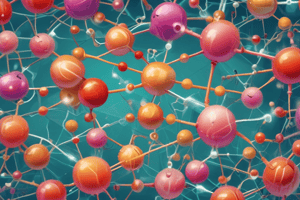Podcast
Questions and Answers
What are lipids and what are their general roles in the body?
What are lipids and what are their general roles in the body?
Lipids are linear chains of C-H bonds that terminate with a carboxyl group (-COOH). They have important roles in storing energy, aiding in proper digestion and absorption of food, acting as structural components in cell membranes, and acting as messengers and signaling molecules within the body.
How are lipids classified based on chain length?
How are lipids classified based on chain length?
Lipids are classified based on chain length as short-chain (4–6 carbon atoms), medium-chain (8–12 carbon atoms), or long-chain (more than 12 carbon atoms). Most fatty acids in our diet usually come in long-chain form.
Why are lipids commonly referred to as fats?
Why are lipids commonly referred to as fats?
Lipids are commonly referred to as fats because they are composed mainly of C-H bonds and are derivatives of fatty acids. They are utilized when energy resources are already depleted.
Why are lipids insoluble in water?
Why are lipids insoluble in water?
What are the types of lipids transported by lipoproteins?
What are the types of lipids transported by lipoproteins?
Flashcards are hidden until you start studying
Study Notes
Lipids and Their Roles
- Lipids are a diverse group of biological molecules that include fats, oils, waxes, and related compounds
- They serve as energy storage molecules, structural components of membranes, and signaling molecules
Classification of Lipids
- Based on chain length, lipids can be classified into short-chain lipids (< 6 carbons), medium-chain lipids (6-12 carbons), and long-chain lipids (> 12 carbons)
Lipids and Fats
- Lipids are commonly referred to as fats because, in everyday language, the terms are often used interchangeably
- However, technically, fats refer to lipids that are solid at room temperature, while oils are lipids that are liquid at room temperature
Insolubility of Lipids
- Lipids are insoluble in water due to their non-polar, hydrophobic nature
- This property makes them difficult to dissolve in water-based bodily fluids
Lipid Transport by Lipoproteins
- Lipoproteins transport various types of lipids, including cholesterol, triglycerides, and phospholipids
- Examples of lipoproteins include chylomicrons, very-low-density lipoproteins (VLDL), low-density lipoproteins (LDL), and high-density lipoproteins (HDL)
Studying That Suits You
Use AI to generate personalized quizzes and flashcards to suit your learning preferences.




